Bavarian's Old Style Beer (1955-1957)
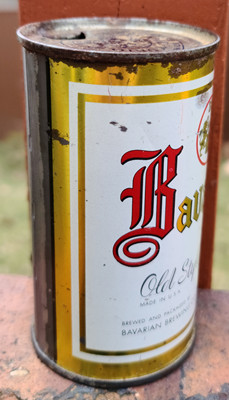 |
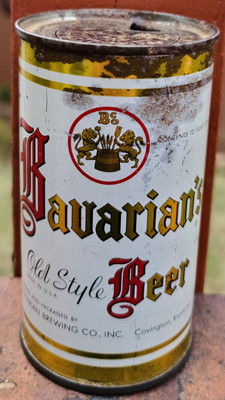 |
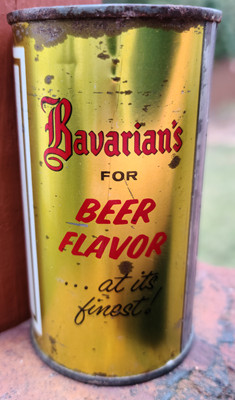 |
This month I want to look at the Bavarian’s Beer from Bavarian Brewing in Covington, Kentucky. It’s not a rare can, but it is somewhat tough to find, and apparently a somewhat short-lived label. I picked this one up in an auction and wanted to narrow down when it came out. I knew Timothy Holian’s Over the Barrel would likely have the answer, but I wanted to dig some for it, simply for the pleasure of working on the question as a puzzle. Then when I checked Holian it could confirm, or contradict, what I had found.
First, a little bit about Bavarian. You can find an excellent website with the brewery’s history at https://www.bavarianbrewery.org/.
History
Founded in 1866, the brewery was incorporated by William Riedlin in 1889 as the Bavarian brewing Company. The Riedlin family controlled it until 1937 and even then, the brewery was controlled until 1959 by a branch of their family. It operated in Covington, Kentucky, directly across the Ohio River from Cincinnati, so it was part of the Cincinnati market, which meant the Bavarian brewery had a lot of competition, but also a large market especially with the sizable German population in the area. The brewery prospered and production increased from 7,000 barrels a year in 1870 to 215,000 by 1914. That’s a respectable amount, even if it didn’t make the brewery one of the area’s largest, it also was not one of the smallest. The brewery had to stop production in late 1918 with Prohibition. Walter Riedlin passed away in early 1919, followed shortly thereafter by his son.
At first during Prohibition (1919-1933 for Kentucky) Bavarian made non-alcoholic ‘near beer” and malt extract, but then the brewery was closed, and the equipment sold. It reopened in 1935, two years after Prohibition ended. The brewery struggled, went into receivership in 1937, and was sold to the Schott family, related to the Riedlin family through marriage.
Under the Schotts, the brewery did better, and prospered in the years right after World War Two. It operated around the clock and they purchased one of the Bruckmann Brewing facilities to use its warehouse in 1948. They also purchased the old Heidelberg Brewery, also in Covington, in 1949. Operating two brewing plants was expensive, however, and a price increase hurt sales. Production dropped from 350,000 barrels a year to 200,000. In 1955 they sold the Heidelberg plant and installed a canning line that could handle flat top cans. That’s where this month’s can comes into play.
The Conetop
Bavarian seems to have started filling conetops right after World War II. The IRTP conetop (1947-1950) are harder to find than the non-IRTP version (1950-1955). Conetops were going out of style in the 1950s however, as flattops became increasingly popular. Conetops had the advantage of being fillable on bottling lines with some adjustments, but by the 1950s flattop canning lines were available as smaller breweries began to shut down and their equipment went up for sale. That’s how Bavarian got their canning line; they bought one used.
Advertisements
The conetop cans appeared in advertisements in the early 1950s. Here are a few of them. Note the “It’s a Man’s Beer that Women Enjoy Too” theme. The brewery seemed to think that their old “It’s a Man’s Beer” theme was turning off women who did the family shopping. (Click on each ad to see a bigger version)
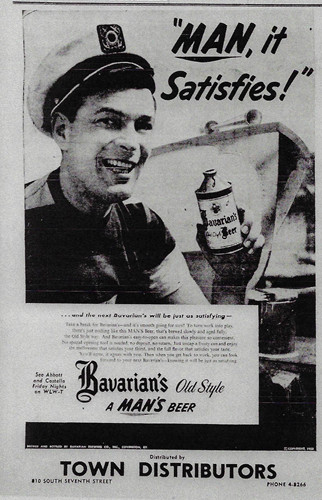 |
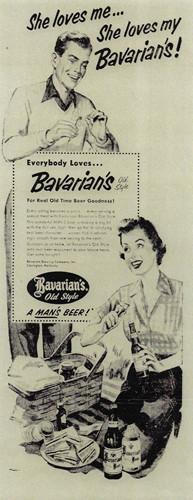 |
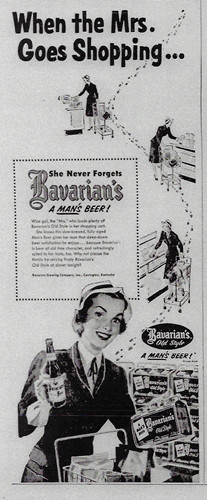 |
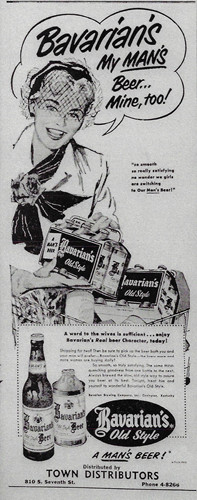 |
A New Slogan
In 1955 Bavarian changed its slogan to “Bavarian’s for Beer Flavor at Its Finest!” It appears on the side of the flat top can, which lasted from roughly spring of 1955 until the spring of 1957. This was the end of their old “It’s a Man’s Beer” phase.
 |
A New Name and a New Label
In spring 1957 Bavarian totally revamped the label to the extent they even renamed their flagship beer. In part this was due to market pressure by Anheuser-Busch. In 1955 AB introduced Busch Bavarian as their entry into the low-priced market. This sparked lawsuits by Bavarian against their much bigger rival for poaching on their brand name. Just last month I featured AB arguing that “Budweiser” was a band name and not a style of beer in order to pressure a tiny competitor. This month’s can is an example of the opposite, AB argued that a brand name (Bavarian) was a style of beer and not a brand name in order to pressure a much smaller competitor. In the end the giant brewery had its way and Bavarian changed the name of their beer to Bavarians Select Beer.
In 1959 International Brewing bought Bavarian. International was an attempt to compete with the big, aggressive breweries by combining the resources of several smaller breweries. This was a tactic under multiple times by several companies, but never seemed to work for the long term. At any rate, International made multiple brands at several sites including Covington, Kentucky; Finley Ohio, Buffalo, New York; and Tampa, Florida. The old Bavarian Brewery lasted until 1966 when International closed up shop. Now it’s used by local government offices.
Looking for Clues
So, what did I find before turning to Over the Barrel for the answer? There were a lot of clues I looked for.
Ads: I found the conetop in brewery advertisements until the summer of 1954. They did not use the cans in enough advertisements that I could find to make this definitive. However it did fit my initial guess at 1955. (I used the Library of Congress site and Newspaperarchives.com).
Canning Codes: The can I have was made by Continental not American can, so there was no canning code which might have shown the can being made before 1955. So this was a washout.
Newspaper Stories: I found stories that indicated the brewery had undergone a leadership change in early 1955 and they had upgraded their facilities. I thought this might be a new canning line as they were upgrading and that seemed like a logical time they’d switch from conetops to flat tops. Plus, this fit the timeline for the general phasing out of conetops by the brewery industry as a whole.
I also found the Brewer’s Digest article from June 1957 about them switching to a new can design, which put an end date for this month’s can. I knew from experience that the brewing industry journals seemed to have a lag time of a month or so in their stories, so that put the label change in the Spring of 1957. Since this was a full page story and not a filler blurb I thought it was likely atimely news story.
Over the Barrel was written with access to resources I don’t have access to, so I take their placing the new canning line in early 1955 as reliable. So this month’s can was produced for maybe two years at most by a small brewery struggling with market share. No wonder it took me so long to find one!
Sources
"Bavarian Brewing Company" Wikipedia (Accessed 9 February 2021)
"For Bavarian: 'Three Flags'" Brewers Digest (June 1957)
Holian, Timothy Over the Barrel (St. Joseph, 2001)
BavarianBrewery.org (Accessed 9 February 2021)
